Mt. Fuji Trivia
- Home
- Mt. Fuji Trivia Danger of Lightning on Mt. Fuji
What’s the scariest thing when climbing Mt. Fuji?
Danger of Lightning on Mt. Fuji
The scariest thing when climbing Mt. Fuji is…
When you ask a guide, mountain hut owner, researchers or at a safety guide center “What’s the scariest thing when climbing Mt. Fuji?”, the answer is always Lightning!
In summer, Mt. Fuji is prone to lightning occurrence.
Besides being indoors, there is no effective way to avoid lightning strike.
That’s why you need to know what to look out for, what to be afraid of, and what to do about it!
(Navigator: Imafuji Grandpa)
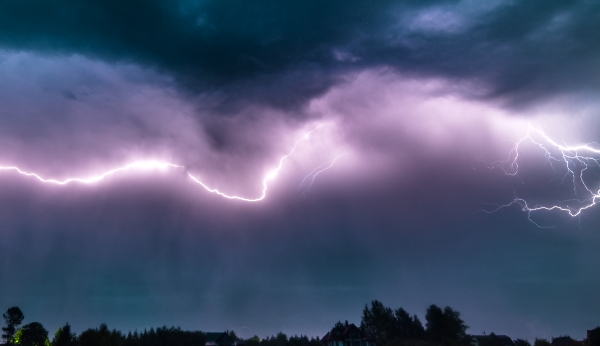

1 Heat thunder
Thunderstorms occur on sunny summer afternoons because of thermal thunderstorms.
The strong rays of the sun heat the surface of the earth and create an updraft, which destabilizes the air and causes cumulonimbus clouds to form, resulting in thunder.
It is traditionally believed that summer thunder lasts three days. Sometimes it lasts for one day, sometimes for four days, but on average it lasts for three days. The reason for this is that the magnitude of the cold air in the upper atmosphere, which is the source of thermal thunderstorms, lasts about three days. It takes about three days for the cold air over Japan to be replaced by the warm air in the lower level. When the upper-level cold air disappears, thunderstorms are no longer generated, and until the next cold air arrives, there is no need to worry about heat thunderstorms, and everybody can enjoy climbing.
2 Weather front thunder
Weather front thunder often appears at the change of seasons.When warm and cold air masses come into contact, they don’t mix immediately but form a cold front and a warm front. Weather front thunder occurs when thunderclouds from near these two fronts.
3 Vortex Thunder
Vortex thunder is generated near the center of a developing low-pressure system or a typhoon, when the air currents blowing in from the surrounding area create a stronger-than-normal updraft. At high temperatures it maintains its strength for a long time and moves fast, so it affects a wide area.
Usually lighting strikes from the sky towards the ground. However, while climbing Mt. Fuji you can find yourself above the thunderclouds.
Lightning can happen below you, right in front of you horizontally and there may be sudden strikes without any thunder!
Thunderstorm clouds form in an altitude between 3000m and 5000m, and i.e. the Fujimiya Ganzo 7th Station is at 3023m.
In other words, you can end up inside a thundercloud, putting you very close to the lightning.
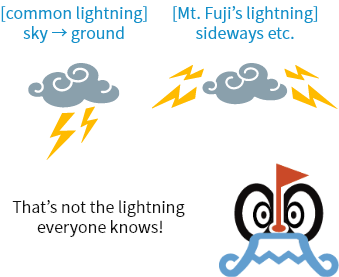

Moreover, it’s even more challenging because from the 5th Station to the summit of the mountain, there are extremely few places to take shelter. Along the climbing routes, the only shelters available are mountain huts and public restrooms. On the Gotemba route, for example, it can take over two hours to reach the next mountain hut.
To avoid encountering lightning during your climb, if there’s a forecast for thunderstorms in the afternoon, it’s crucial to plan to reach a mountain hut by the morning, change your plan to descend to a safe location, or have the courage to cancel your climb altogether. In any case, thorough preparation and planning is important.
Useful lightning information
1 Thunderstorm Warning [Japan Meteorological Agency]
A thunderstorm warning is issued by the Japan Meteorological Agency when there is a risk of damage to people and buildings due to severe weather phenomena such as lightning, sudden strong storms, storms such as tornadoes, and hailstorms that occur as cumulonimbus clouds develop.
The important point is that there is no “lightning warning”! Even if the conditions are extremely dangerous, they only issue a “thunderstorm warning”.

2 Lightning Observation Information [Japan Meteorological Agency]
Ground discharges (lightning strikes) for the last 5min are shown. You can see the data for the past 3 hours.
So it is possible to make some predictions about the amount of thunderclouds and there movement in the future.
3 ThunderNOW cast [Japan Meteorological Agency]
The Thunder Nowcast analyzes the intensity of lightning and the likelihood of thunderstorms in 1 km grid units and provides forecasts for the next hour (10 to 60 minutes ahead).
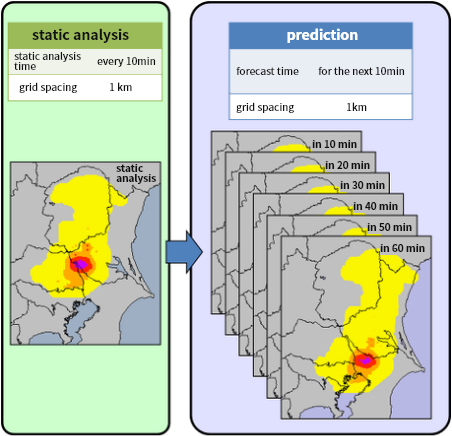
The activity levels are listed below: 1 to 4.

Thunderclouds can develop suddenly, so be aware of sudden changes in the weather even in areas where there is no activity.

4 Blitzortung.org
What is Blitzortung.org
In 2012, Professor Dr. Egon Wanke from Heinrich Heine University in Germany initiated the “Blitzortung.org” project. This global initiative aimed to provide free, high-precision lightning location information worldwide.
The project’s goal is to create a low-cost, worldwide lightning sensor network. This network is operated by volunteers who maintain the lightning sensors. When a sensor detects noise that it determines to be lightning, it sends this information to a central server. The server then uses the time differences in the arrival of this noise at various sensors to pinpoint the exact location of the lightning strike.
Additionally, “Imafuji,” a group from Shizuoka Institute of Science and Technology, collaborates with this project by placing a lightning sensor at the meteorological observation point at the First Station of the Yoshida route on Mount Fuji.
Disclaimer
- The accuracy of lightning location detection is not constant due to factors such as the noise environment around the lightning sensor.
- Not all lightning locations are identified.
- The operation of this network itself is being conducted as research.
Due to these three points, the accuracy of the lightning location information obtained here cannot be guaranteed. Please use it at your own discretion and for reference only. There is no guarantee whatsoever regarding any accidents, disadvantages, or other troubles that may arise from using this information.
5 Deadly Warning Sign: “Hair Standing on End”
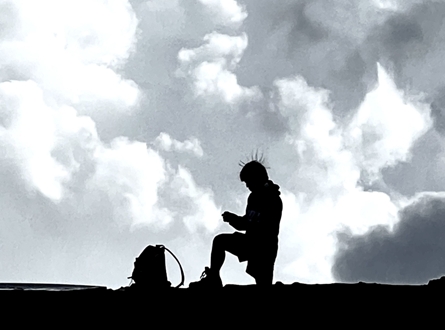
Photo: Hair standing on end from static electricity during a mountain climb
(Photo credit: Megumi Ueda)
Have you ever felt your hair suddenly stand on end while hiking? Or noticed someone else’s hair doing the same? That strange sensation might be a final warning from nature—it could mean a lightning strike is seconds away.
When lightning draws near, intense static electricity builds up in the air.
Your body can become electrically charged, causing your hair to lift. This eerie phenomenon signals an extremely dangerous situation: a lightning strike may be imminent, or it may already have started. Immediate action is necessary to protect yourself from being struck.

6 How to protect yourself from lightning
How to protect yourself from lightning
1 Seek shelter in a mountain hut or indoor location
Even if you hear a faint rumble of thunder in the distance, consider it as a danger signal that lightning may strike your own body and evacuate immediately! Keep an eye on the sound of thunder and the sky, and if you detect the sound of thunder, take shelter in a building as soon as possible.

2 If there’s no shelter move away from trees!
It is dangerous near trees. Stay away from them during thunderstorms.
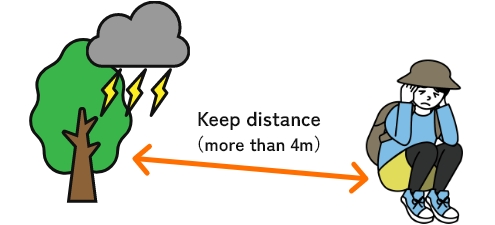
3 Basic posture if you are stuck without a shelter
If there is no place to escape to, bend your upper body forward with both feet together and your knees bent at the knees, block your ears with both thumbs to prevent your membranes from being torn by the thunderclap, and hold your head down with your remaining fingers and wait for the lightning storm to pass.
Lying on your stomach on the ground carries the risk of ventricular fibrillation (cardiac arrest) due to stride voltage caused by lightning current to the nearby ground and creeping discharge between the ground and your body surface.
Your first thoughts should be seeking refuge in a nearby structure, getting into your car if you are near the fifth station, or moving from the ridge to the valley if you are in the mountains!

references
- The Thunder Doctor Teaches the Secrets of Protecting Yourself from Lightning –Kitagawa Shinichiro(ISBN978-4-7807-0330-6)
- The Science of Lightning and Thunderclouds – How to Protect Yourself from Lightning –Kitagawa Shinichiro(ISBN4-627-29081-0)
- Weather Observation for Mountain Climbers –Kidokoro Kunio(OSBN4-635-04315-0)



